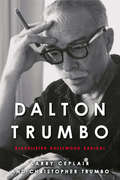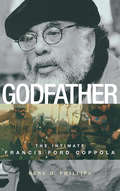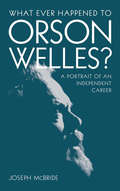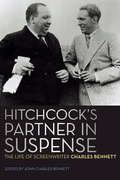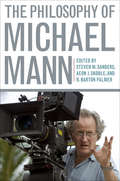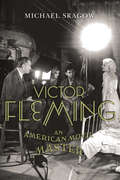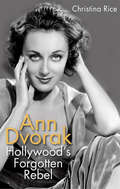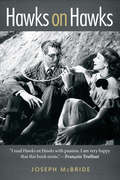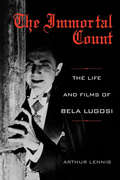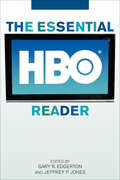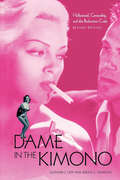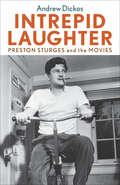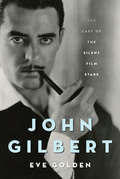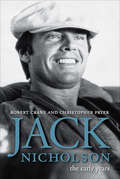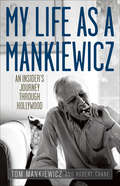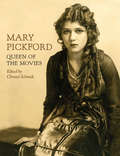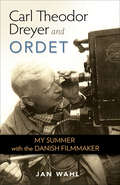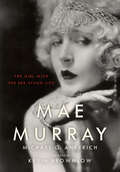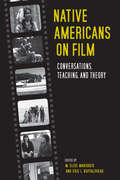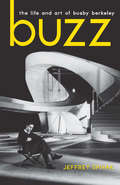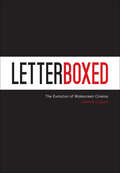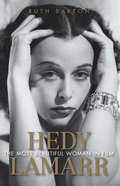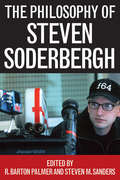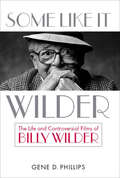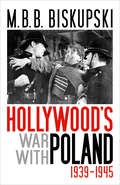- Table View
- List View
Dalton Trumbo: Blacklisted Hollywood Radical (Screen Classics)
by Larry Ceplair Christopher TrumboJames Dalton Trumbo (1905--1976) is widely recognized for his work as a screenwriter, playwright, and author, but he is also remembered as one of the Hollywood Ten who opposed the House Un-American Activities Committee. Refusing to answer questions about his prior involvement with the Communist Party, Trumbo sacrificed a successful career in Hollywood to stand up for his rights and defend political freedom.In Dalton Trumbo, authors Larry Ceplair and Christopher Trumbo present their extensive research on the famed writer, detailing his work, his membership in the Communist Party, his long campaign against censorship during the domestic cold war, his ten-month prison sentence for contempt of Congress, and his thirteen-year struggle to break the blacklist.The blacklist ended for Trumbo in 1960, when he received screen credits for Exodus and Spartacus. Just before his death, he received a long-delayed Academy Award for The Brave One, and in 1993, he was posthumously given an Academy Award for Roman Holiday (1953). This comprehensive biography provides insights into the many notable people with whom Trumbo worked, including Stanley Kubrick, Otto Preminger, and Kirk Douglas, and offers a fascinating look at the life of one of Hollywood's most prominent screenwriters and his battle against persecution.
Godfather: The Intimate Francis Ford Coppola
by Gene D. PhillipsWITH A FOREWORD BY WALTER MURCH Gene Phillips blends biography, studio history, and film criticism to complete the most comprehensive work on Coppola ever written. The force behind such popular and critically acclaimed films as Apocalypse Now and the Godfather trilogy, Coppola has imprinted his distinct style on each of his movies and on the landscape of American popular culture. In Godfather, Phillips argues that Coppola has repeatedly bucked the Hollywood "factory system" in an attempt to create distinct films that reflect his own artistic vision -- often to the detriment of his career and finances. Phillips conducted interviews with the director and his colleagues and examined Coppola's production journals and screenplays. Phillips also reviewed rare copies of Coppola's student films, his early excursions into soft-core pornography, and his less celebrated productions such as One from the Heart and Tucker: The Man and His Dream. The result is the definitive assessment of one of Hollywood's most enduring and misunderstood mavericks.
What Ever Happened to Orson Welles?: A Portrait of an Independent Career
by Joseph McBrideAt twenty-five, Orson Welles (1915-1985) directed, co-wrote, and starred in Citizen Kane, widely considered the best film ever made. But Welles was such a revolutionary filmmaker that he found himself at odds with the Hollywood studio system. His work was so far ahead of its time that he never regained the wide popular following he had once enjoyed as a young actor-director on the radio. Frustrated by Hollywood and falling victim to the postwar blacklist, Welles departed for a long European exile. But he kept making films, functioning with the creative freedom of an independent filmmaker before that term became common and eventually preserving his independence by funding virtually all his own projects. Because he worked defiantly outside the system, Welles has often been maligned as an errant genius who squandered his early promise. Film critic Joseph McBride, who acted in Welles's legendary unfinished film The Other Side of the Wind, provocatively challenges conventional wisdom about Welles's supposed creative decline. McBride is the first author to provide a comprehensive examination of the films of Welles's artistically rich yet little-known later period. During the 1970s and '80s, Welles was breaking new aesthetic ground, experimenting as adventurously as he had throughout his career. McBride's friendship and collaboration with Welles and his interviews with those who knew and worked with the director make What Ever Happened to Orson Welles? a portrait of rare intimacy and insight. Reassessing Welles's final period in the context of his entire life and work, McBride's revealing portrait of this great film artist will change the terms of how Orson Welles is regarded.
Hitchcock’s Partner in Suspense: The Life of Screenwriter Charles Bennett (Screen Classics)
by Charles BennettWith a career that spanned from the silent era to the 1990s, British screenwriter Charles Bennett (1899--1995) lived an extraordinary life. His experiences as an actor, director, playwright, film and television writer, and novelist in both England and Hollywood left him with many amusing anecdotes, opinions about his craft, and impressions of the many famous people he knew. Among other things, Bennett was a decorated WWI hero, an eminent Shakespearean actor, and an Allied spy and propagandist during WWII, but he is best remembered for his commercially and critically acclaimed collaborations with directors Sir Alfred Hitchcock and Cecil B. DeMille.The fruitful partnership began after Hitchcock adapted Bennett's play Blackmail (1929) as the first British sound film. Their partnership produced six thrillers: The Man Who Knew Too Much (1934), The 39 Steps (1935), Sabotage (1936), Secret Agent (1936), Young and Innocent (1937), and Foreign Correspondent (1940). In this witty and intriguing book, Bennett discusses how their collaboration created such famous motifs as the "wrong man accused" device and the MacGuffin. He also takes readers behind the scenes with the Master of Suspense, offering his thoughts on the director's work, sense of humor, and personal life.Featuring an introduction and additional biographical material from Bennett's son, editor John Charles Bennett, Hitchcock's Partner in Suspense is a richly detailed narrative of a remarkable yet often-overlooked figure in film history.
The Philosophy of Michael Mann (The Philosophy of Popular Culture)
by Aeon J. Skoble R. Barton Palmer Steven SandersA collection of essays exploring the philosophical themes and aesthetic vision behind blockbuster film including The Insider, Public Enemies,and more.Known for his finely crafted crime thrillers, American filmmaker Michael Mann has long been regarded as a talented triple threat capable of moving effortlessly between television and feature films as a writer, director, and executive producer. His unique visual sense and thematic approach are evident in the Emmy Award-winning The Jericho Mile, the cult favorite The Keep, the American epic The Last of the Mohicans, and the Academy Award-nominated The Insider, as well as more recent works such as Ali, Miami Vice, and Public Enemies.The Philosophy of Michael Mann provides a comprehensive account of the work of this highly accomplished filmmaker, exploring the director's recognizable visual style and the various on-screen and philosophical elements he has tested in his thirty-five-year career. The essays in this wide-ranging book will appeal to fans of the revolutionary filmmaker and to philosophical scholars interested in the themes and conflicts that drive his movies.
Victor Fleming: An American Movie Master (Screen Classics)
by Michael SragowThis definitive biography chronicles the life and work of the legendary director of Gone With the Wind and The Wizard of Oz.Victor Fleming was the most sought-after director in Hollywood’s golden age, renowned for his work across an astounding range of genres—from gritty westerns to screwball comedies, romances, boddy pictures, and family entertainment. Yet this chameleon-like versatility has resulted in his relative obscurity today—despite his having directed two of the most iconic movies of all time.Fleming is best remembered for Gone With the Wind and The Wizard of Oz, but he directed more than forty films, including classics like Red Dust, Test Pilot, Dr. Jekyll and Mr. Hyde, and Captains Courageous. Fleming created enduring screen personas for Clark Gable, Spencer Tracy, and Gary Cooper, as well as for Ingrid Bergman, Clara Bow, and Norma Shearer—who were among his many lovers.In this definitive biography, Michael Sragow restores the director to the pantheon of great American filmmakers, correcting a major oversight in Hollywood history. It is the dramatic story of a man at the center of the most exciting period in American filmmaking.
Ann Dvorak: Hollywood's Forgotten Rebel (Screen Classics)
by Christina RicePossessing a unique beauty and refined acting skills, Ann Dvorak (1911--1979) found success in Hollywood at a time when many actors were still struggling to adapt to the era of talkies. Seemingly destined for A-list fame, critics touted her as "Hollywood's New Cinderella" after film mogul Howard Hughes cast her as Cesca in the gangster film Scarface (1932). Dvorak's journey to superstardom was derailed when she walked out on her contractual obligations to Warner Bros. for an extended honeymoon. Later, she initiated a legal dispute over her contract, an action that was unprecedented at a time when studios exercised complete control over actors' careers.As the first full-length biography of an often-overlooked actress, Ann Dvorak: Hollywood's Forgotten Rebel explores the life and career of one of the first individuals who dared to challenge the studio system that ruled Tinseltown. The actress reached her pinnacle during the early 1930s, when the film industry was relatively uncensored and free to produce movies with more daring storylines. She played several female leads in films including The Strange Love of Molly Louvain (1932), Three on a Match (1932), and Heat Lightning (1934), but after her walk-out, Warner Bros retaliated by casting her in less significant roles.Following the casting conflicts and illness, Dvorak filed a lawsuit against the Warner Bros. studio, setting a precedent for other stars who eventually rebelled against the established Hollywood system. In this insightful memoir, Christina Rice explores the spirited rebellion of a talented actress whose promising career fell victim to the studio empire.
Hawks on Hawks (Screen Classics)
by Joseph McBrideA portrait of the renowned film director based on seven years of interviews: “I am very happy that this book exists.” —François TruffautHoward Hawks is often credited as the most versatile of the great American directors, having worked with equal ease in screwball comedies, westerns, gangster movies, musicals, and adventure films. He directed an impressive number of Hollywood’s greatest stars—including Humphrey Bogart, Cary Grant, John Wayne, Lauren Bacall, Rosalind Russell, and Marilyn Monroe—and some of his most celebrated films include Scarface, Bringing Up Baby, The Big Sleep, Red River, Gentlemen Prefer Blondes, and Rio Bravo.Hawks on Hawks draws on interviews that author Joseph McBride conducted with the director over the course of seven years, giving rare insight into Hawks’s artistic philosophy, his relationships with the stars, and his position in an industry that was rapidly changing. In its new edition, this classic book is both an account of the film legend’s life and work and a guidebook on how to make movies.“There are going to be many biographies of Howard Hawks, but they will all lean heavily on this book; the pioneer so honestly reveals himself and the people with whom he worked.” —Los Angeles Times
The Immortal Count: The Life and Films of Bela Lugosi
by Arthur LennigIn the 1931 film Dracula, Bela Lugosi set the standard for horror film villainy. Though many actors have donned the cape since that first production, remnants of Hungarian-born Lugosi's portrayal continue to surface in popular culture -- from highly prized memorabilia to a character on Sesame Street. After a decade of trying vainly to broaden his range, Lugosi gave up his ambitions and began to support himself with roles that were all in some way a variation of the first. Ultimately, Lugosi became a sad parody of his former self, and the last years of his life were marked by financial crises, family turmoil, and drug addiction. Offering new insights into the films and personality of an actor who could not overcome Hollywood typecasting, The Immortal Count is the definitive account of Lugosi's tragic life.
The Essential HBO Reader (Essential Readers in Contemporary Media and Culture)
by Gary R. Edgerton and Jeffrey P. JonesEssays on the history of HBO, a company designed to please audiences instead of advertisers, and the impact of its distinctive programming: “Recommended.” —ChoiceThe founding of Home Box Office in the early 1970s—when it debuted by telecasting a Paul Newman movie and an NHL game to 365 households in Wilkes-Barre, Pennsylvania—was a harbinger of the innovations that would transform television as an industry and a technology in the decades that followed. HBO quickly became synonymous with subscription television—and the leading force in cable programming.Over decades, it’s grown from a domestic movie channel to an international powerhouse with a presence in over seventy countries. It is now a full-service content provider with a distinctive brand of original programming, famed for such landmark shows as The Sopranos and Sex and the City. It’s brought us Six Feet Under and The Wire, Band of Brothers and Angels in America, Curb Your Enthusiasm and Def Comedy Jam, Inside the NFL and Real Sports with Bryant Gumbel, Taxicab Confessions and Autopsy, and multiple Oscar-winning documentaries.The Essential HBO Reader brings together an accomplished group of scholars to explain how HBO’s programming transformed the world of television and popular culture, and provides a comprehensive and compelling examination of HBO’s development into the prototypical entertainment corporation of the twenty-first century.“An important assessment of the original programming HBO has created in the past few decades?how these programs are derived and what impact they have had.” —Choice“A thorough treatment of HBO’s programming . . . a useful addition to a growing number of books about American television in the ‘post-network’ era.” —American Studies
The Dame in the Kimono: Hollywood, Censorship, and the Production Code
by Leonard J. Leff Jerold L. Simmons“This excellent, lively study examines the ‘raucous debate’ sparked by the Code over the morals and ideals of American movies.” —Publishers WeeklyThe new edition of this seminal work takes the story of the Production Code and motion picture censorship into the present, including the creation of the PG-13 and NC-17 ratings in the 1990s.Starting in the early 1930s, the Production Code Director, Joe Breen, and his successor, Geoff Shurlock, understood that American motion pictures needed enough rope—enough sex, and violence, and tang—to lasso an audience, and not enough to strangle the industry. To explore the history and implementation of the Motion Picture Production Code, this book uses 11 movies: Dead End, GoneWith the Wind, The Outlaw, The Postman Always Rings Twice, The Bicycle Thief, Detective Story, A Streetcar Named Desire, The Moon Is Blue, The French Line, Lolita, and Who’s Afraid of Virginia Woolf? The authors combine a lively style with provocative insights and a wealth of anecdotes to show how the code helped shape American screen content for nearly 50 years.“A readable, intimate account of the rise to near-tyrannical power, and the fall to well-deserved ignominy, of the old Production Code Administration.” —Atlantic Monthly“A valuable insight into our own innocence and naiveté.” —The New York Times Book Review“The triumph of Leff and Simmons’s fine work is that they have reminded us of how fatuous and inimical a code of conduct can be: how tempting it is as a theoretical answer, and how intrinsically flawed it is as a working solution.” —The Times of London
Intrepid Laughter: Preston Sturges and the Movies (Screen Classics)
by Andrew DickosThe life and career of the pioneering writer-director whose name is synonymous with sophisticated screwball comedies.Preston Sturges was known for bringing sophistication and wit to the genre of comedy, establishing himself as one of the most valuable writer-directors in 1940s Hollywood. Today, more than a half century after they were originally produced, his films have lost little of their edge and remain extremely popular.Intrepid Laughter is an essential guide to the life and work of this luminary of the stage and screen, following Sturges from his unusual childhood, to his early success as a Broadway playwright, to his whirlwind career in Hollywood.
John Gilbert: The Last of the Silent Film Stars (Screen Classics)
by Eve GoldenCharming and classically handsome, John Gilbert (1897--1936) was among the world's most recognizable actors during the silent era. He was a wild, swashbuckling figure on screen and off, and accounts of his life have focused on his high-profile romances with Greta Garbo and Marlene Dietrich, his legendary conflicts with Louis B. Mayer, his four tumultuous marriages, and his swift decline after the introduction of talkies. A dramatic and interesting personality, Gilbert served as one of the primary inspirations for the character of George Valentin in the Academy Award--winning movie The Artist (2011). Many myths have developed around the larger-than-life star in the eighty years since his untimely death, but this definitive biography sets the record straight.Eve Golden separates fact from fiction in John Gilbert: The Last of the Silent Film Stars, tracing the actor's life from his youth spent traveling with his mother in acting troupes to the peak of fame at MGM, where he starred opposite Mae Murray, Norma Shearer, Joan Crawford, Greta Garbo, and other actresses in popular films such as TheMerry Widow (1925), The Big Parade (1925), Flesh and the Devil (1926), and Love (1927). Golden debunks some of the most pernicious rumors about the actor, including the oft-repeated myth that he had a high-pitched, squeaky voice that ruined his career. Meticulous, comprehensive, and generously illustrated, this book provides a behind-the-scenes look at one of the silent era's greatest stars and the glamorous yet brutal world in which he lived.
Jack Nicholson: The Early Years (Screen Classics)
by Robert Crane Christopher FryerOriginally published as Jack Nicholson: Face to Face in 1975, Jack Nicholson: The Early Years is the first book written about the enigmatic star and the only one to have Nicholson's participation. In 1975 Nicholson was just becoming a household name in spite of having already starred in, written or produced 25 films including classics such as Easy Rider (1969), Five Easy Pieces (1970), The Last Detail (1973) and Chinatown (1974). To date, Nicholson has been nominated for twelve Academy Awards and won three, has garnered seven Golden Globe awards, and took home the American Film Institute's Life Achievement Award at the age of 57. Authors Robert Crane and Christopher Fryer interviewed Nicholson for what began as a thesis for a University of Southern California film class but which quickly morphed into a larger portrait of Nicholson's unique craft. Crane and Fryer conducted their interviews with Nicholson with the intent of showcasing the young star as he saw himself, while also interviewing many of Nicholson's close friends and fellow filmmakers, including Dennis Hopper, Roger Corman, Hal Ashby, Ann-Margret, Robert Evans and Bruce Dern, providing a comprehensive profile of the actor's early years in the industry. The result is a true insider's look at Nicholson not only as a writer, director and actor, but also offers insights into a private man's private life. Jack Nicholson: The Early Years stands as a testament to his incredible success in Hollywood.
My Life as a Mankiewicz: An Insider's Journey Through Hollywood (Screen Classics)
by Tom Mankiewicz Robert Crane“A treasure trove of observations and anecdotes about Hollywood from the 1960s to the 1980s and the people who made the movies back then.” —Associated PressThe son of famed director and screenwriter Joseph L. Mankiewicz and the nephew of Citizen Kane screenwriter Herman Mankiewicz, Tom Mankiewicz was genuine Hollywood royalty. He grew up in Beverly Hills and New York, spent summers on his dad’s film sets, had his first drink with Humphrey Bogart, dined with Elizabeth Taylor and Richard Burton, went to the theater with Ava Gardner, and traveled the world writing for Brando, Sinatra, and Connery. Although his family connections led him to show business, Tom “Mank” Mankiewicz forged a career of his own, becoming a renowned screenwriter, director, and producer of acclaimed films and television shows. He wrote screenplays for three James Bond films—Diamonds Are Forever (1971), Live and Let Die (1973), and The Man with the Golden Gun (1974)—and made his directorial debut with the hit TV series Hart to Hart (1979-1984). My Life as a Mankiewicz is a fascinating look at the life of an individual whose creativity and work ethic established him as a member of the Hollywood writing elite.My Life as a Mankiewicz illuminates his professional development as a writer and director, detailing his friendships and romantic relationships with some of Hollywood’s biggest stars as well as his struggle with alcohol and drugs. With the assistance of Robert Crane, Mankiewicz tells a story of personal achievement and offers an insider’s view of the glamorous world of Hollywood during the 1960s, 1970s, and 1980s.
Mary Pickford: Queen of the Movies
by Christel Schmidt&“Explains Pickford&’s roles as not only a talented actress, but also as a philanthropist and industry leader who managed to end up her own producer.&” —Time Out In the early days of cinema, when actors were unbilled and unmentioned in credits, audiences immediately noticed Mary Pickford. Moviegoers everywhere were riveted by her magnetic talent and appeal as she rose to become cinema&’s first great star. In this engaging collection, co-published with the Library of Congress, an eminent group of film historians sheds new light on this icon&’s incredible life and legacy. Pickford emerges from the pages in vivid detail, revealed as a gifted actress, a philanthropist, and a savvy industry leader who fought for creative control of her films and ultimately became her own producer. With extensive photos and illustrations, this book paints a fascinating portrait of a key figure in American cinematic history. Includes over 200 photos, illustrations, and stills from the collections of the Library of Congress and Academy of Motion Picture Arts and Sciences
Carl Theodor Dreyer and Ordet: My Summer with the Danish Filmmaker (Screen Classics)
by Jan WahlThis illustrated memoir shares a rare inside look at the legendary director’s process and vision during the filming of his award-winning masterpiece.Danish director Carl Theodor Dreyer is considered one of the most influential filmmakers in cinematic history. His 1955 film Ordet (The World) won numerous prizes, including the Venice Film Festival’s Golden Lion. In 1954, Dreyer invited young film student Jan Wahl to accompany him during this classic work.This captivating account of Wahl's time with the director is based on Wahl's daily journal and transcriptions of his conversations with Dreyer. Offering a glimpse into the filmmaker's world, Wahl fashions a portrait of Dreyer as a man, mentor, friend, and director. Wahl's detailed account is supplemented by exquisite photos of the filming and by selections from Dreyer's papers, including his notes on film style, his introduction for the actors before the filming of Ordet, and a visionary lecture he delivered at Edinburgh.
Mae Murray: The Girl with the Bee-Stung Lips (Screen Classics)
by Michael G. AnkerichMae Murray (1885--1965), popularly known as "the girl with the bee-stung lips," was a fiery presence in silent-era Hollywood. Renowned for her classic beauty and charismatic presence, she rocketed to stardom as a dancer in the Ziegfeld Follies, moving across the country to star in her first film, To Have and to Hold, in 1916. An instant hit with audiences, Murray soon became one of the most famous names in Tinseltown.However, Murray's moment in the spotlight was fleeting. The introduction of talkies, a string of failed marriages, a serious career blunder, and a number of bitter legal battles left the former star in a state of poverty and mental instability that she would never overcome.In this intriguing biography, Michael G. Ankerich traces Murray's career from the footlights of Broadway to the klieg lights of Hollywood, recounting her impressive body of work on the stage and screen and charting her rapid ascent to fame and decline into obscurity. Featuring exclusive interviews with Murray's only son, Daniel, and with actor George Hamilton, whom the actress closely befriended at the end of her life, Ankerich restores this important figure in early film to the limelight.
Native Americans on Film: Conversations, Teaching, and Theory
by M. Elise Marubbio and Eric L. Buffalohead“An essential book for courses on Native film, indigenous media, not to mention more general courses . . . A very impressive and useful collection.” —Randolph Lewis, author of Navajo Talking PictureThe film industry and mainstream popular culture are notorious for promoting stereotypical images of Native Americans: the noble and ignoble savage, the pronoun-challenged sidekick, the ruthless warrior, the female drudge, the princess, the sexualized maiden, the drunk, and others. Over the years, Indigenous filmmakers have both challenged these representations and moved past them, offering their own distinct forms of cinematic expression.Native Americans on Film draws inspiration from the Indigenous film movement, bringing filmmakers into an intertextual conversation with academics from a variety of disciplines. The resulting dialogue opens a myriad of possibilities for engaging students with ongoing debates: What is Indigenous film? Who is an Indigenous filmmaker? What are Native filmmakers saying about Indigenous film and their own work? This thought-provoking text offers theoretical approaches to understanding Native cinema, includes pedagogical strategies for teaching particular films, and validates the different voices, approaches, and worldviews that emerge across the movement.“Accomplished scholars in the emerging field of Native film studies, Marubbio and Buffalohead . . . focus clearly on the needs of this field. They do scholars and students of Native film a great service by reprinting four seminal and provocative essays.” —James Ruppert, author of Meditation in Contemporary Native American Literature“Succeed[s] in depicting the complexities in study, teaching, and creating Native film . . . Regardless of an individual’s level of knowledge and expertise in Native film, Native Americans on Film is a valuable read for anyone interested in this topic.” —Studies in American Indian Literatures
Buzz: The Life and Art of Busby Berkeley (Screen Classics)
by Jeffrey SpivakCharacterized by grandiose song-and-dance numbers featuring ornate geometric patterns and mimicked in many modern films, Busby Berkeley's unique artistry is as recognizable and striking as ever. From his years on Broadway to the director's chair, Berkeley is notorious for his inventiveness and signature style. Through sensational films like 42nd Street (1933), Gold Diggers of 1933 (1933), Footlight Parade (1933), and Dames (1934), Berkeley sought to distract audiences from the troubles of the Great Depression. Although his bold technique is familiar to millions of moviegoers, Berkeley's life remains a mystery.Buzz: The Life and Art of Busby Berkeley is a telling portrait of the filmmaker who revolutionized the musical and changed the world of choreography. Berkeley pioneered many conventions still in use today, including the famous "parade of faces" technique, which lends an identity to each anonymous performer in a close-up. Carefully arranging dancers in complex and beautiful formations, Berkeley captured perspectives never seen before.Jeffrey Spivak's meticulous research magnifies the career and personal life of this beloved filmmaker. Employing personal letters, interviews, studio memoranda, and Berkeley's private memoirs, Spivak unveils the colorful life of one of cinema's greatest artists.
Letterboxed: The Evolution of Widescreen Cinema
by Harper CossarWhen widescreen technology was introduced to filmmaking in 1953, it changed the visual framework and aesthetic qualities of cinema forever. Before widescreen, a director's vision for capturing beautiful landscapes or city skylines was limited by what coul
Hedy Lamarr: The Most Beautiful Woman in Film (Screen Classics)
by Ruth BartonHedy Lamarr's life was punctuated by salacious rumors and public scandal, but it was her stunning looks and classic Hollywood glamour that continuously captivated audiences. Born Hedwig Kiesler, she escaped an unhappy marriage with arms dealer Fritz Mandl in Austria to try her luck in Hollywood, where her striking appearance made her a screen legend. Her notorious nude role in the erotic Czech film Ecstasy (1933), as well as her work with Cecil B. DeMille ( Samson and Delilah, 1949), Walter Wanger ( Algiers, 1938), and studio executive Louis B. Mayer catapulted her alluring and provocative reputation as a high-profile sex symbol.In Hedy Lamarr: The Most Beautiful Woman in Film, Ruth Barton explores the many facets of the screen legend, including her life as an inventor. Working with avant-garde composer and film scorer George Antheil, Lamarr helped to develop and patent spread spectrum technology, which is still used in mobile phone communication. However, despite her screen persona and scientific success, Lamarr's personal life caused quite a scandal. A string of failed marriages, a lawsuit against her publisher regarding her sensational autobiography, and shoplifting charges made her infamous beyond her celebrity.Drawing on extensive research into both the recorded truths of Lamarr's life and the rumors that made her notorious, Barton recognizes Lamarr's contributions to both film and technology while revealing the controversial and conflicted woman underneath. Hedy Lamarr: The Most Beautiful Woman in Film illuminates the life of a classic Hollywood icon.
The Philosophy of Steven Soderbergh (The Philosophy of Popular Culture #Ppcs)
by R. Barton Palmer Steven M. SandersWidely regarded as a turning point in American independent cinema, Steven Soderbergh's sex, lies, and videotape (1989) launched the career of its twenty-six-year-old director, whose debut film was nominated for an Academy Award and went on to win the Cannes Film Festival's top award, the Palme d'Or. The Philosophy of Steven Soderbergh breaks new ground by investigating salient philosophical themes through the unique story lines and innovative approaches to filmmaking that distinguish this celebrated artist.Editors R. Barton Palmer and Steven M. Sanders have brought together leading scholars in philosophy and film studies for the first systematic analysis of Soderbergh's entire body of work, offering the first in-depth exploration of the philosophical ideas that form the basis of the work of one of the most commercially successful and consistently inventive filmmakers of our time.
Some Like It Wilder: The Life and Controversial Films of Billy Wilder (Screen Classics #Sccl)
by Gene D. PhillipsA biography of the six-time Oscar-winning director of films like Some Like It Hot and Double Indemnity, featuring analysis of his work.Although his career spanned fifty years and included more than fifty films, Austrian-American film director Billy Wilder (1906-2002) may be best known for the legendary shot of Marilyn Monroe’s dress billowing over a subway grating in The Seven Year Itch (1955). This “shot seen round the world” is representative not only of Hollywood’s golden era of cinema but also of one of its most prolific and brilliant directors. Wilder, whose filmography includes such classics as Sunset Boulevard (1950), Sabrina (1954), Witness for the Prosecution (1957), and Some Like It Hot (1959), is often remembered for his versatility, biting wit, and passion for challenging social and moral conventions.Author Gene D. Phillips departs from the traditional biography in Some Like It Wilder, offering new insights into the acclaimed director’s professional and private life. In preparation for the book, Phillips conducted personal interviews with Wilder and other key players from the legendary director’s life and times. Phillips’s unique combination of analysis and biographical detail brings Wilder to life, as both an artist and man.Phillips traces Wilder’s path from Berlin, where he worked as a scriptwriter for one of the city’s largest studios, to Hollywood, where he would quickly establish himself as a premier film director. Forming a partnership with writer-producer Charles Brackett, Wilder directed the classic films Five Graves to Cairo (1943), Double Indemnity (1945), and The Lost Weekend (1945), which earned Academy Awards for best picture, best director, and best screenplay. During the 1960s, Wilder continued to direct and produce controversial comedies, including Kiss Me Stupid (1964) and The Apartment (1960). The Apartment brought Wilder another round of Oscars for best picture, best director, and best screenplay.Wilder’s maverick approach and independent artistic vision pushed boundaries and ensured his legacy as one of the Hollywood greats. Sharply written, Some Like It Wilder serves as a comprehensive companion to Wilder’s films, offering a personalized and heartfelt account of the life and genius of this compelling director.Praise for Some Like It Wilder“Featuring Gene D. Phillips’ unique, in-depth critical approach, Some Like It Wilder . . . provides a groundbreaking overview of a filmmaking icon . . . . This definitive biography reveals that Wilder was, and remains, one of the most influential directors in filmmaking.” —Turner Classic Movies“[Phillips] goes beyond the surface and deep into the complex mind and soul of the famous film director . . . . This book is, in my view, definitive.” —Vincent LoBrutto, author of Martin Scorsese: A Biography
Hollywood's War with Poland, 1939–1945
by M.B.B. BiskupskiDuring World War II, Hollywood studios supported the war effort by making patriotic movies designed to raise the nation's morale. They often portrayed the combatants in very simple terms: Americans and their allies were heroes, and everyone else was a villain. Norway, France, Czechoslovakia, and England were all good because they had been invaded or victimized by Nazi Germany. Poland, however, was represented in a negative light in numerous movies. In Hollywood's War with Poland, 1939-1945, M. B. B. Biskupski draws on a close study of prewar and wartime films such as To Be or Not to Be (1942), In Our Time (1944), and None Shall Escape (1944). He researched memoirs, letters, diaries, and memoranda written by screenwriters, directors, studio heads, and actors to explore the negative portrayal of Poland during World War II. Biskupski also examines the political climate that influenced Hollywood films.
